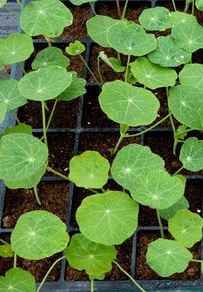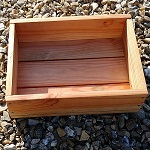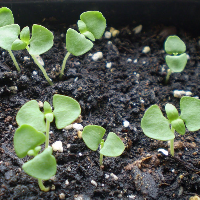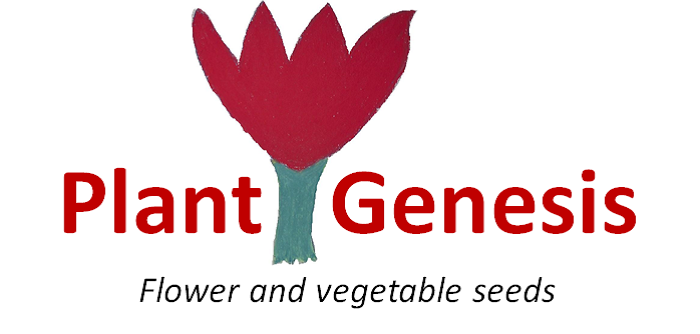Canít do it! Canít do it! I donít believe seeds grow for me!
This post is for those of you who are nervous about
sowing seeds. Inside all of us are two sets
of green fingers just waiting to emerge.
Early spring is approaching and now
is the time to suck in your breath and give it a go!
Growing your own plants from seed is such a rewarding
experience, and is not that difficult. You just need to know how to get started, and
with a little experience you will be amazed at what you can grow. There is nothing like growing from seed to get
to know your plants. Donít treat them
like commodities Ė they are your friends Ė and they will reward you with years
of flowers if you treat them right!
Here are some suggestions to overcome your doubts and
get sowing with success.
Start easy
Start by sowing the seeds of annual plants. These plants germinate, flower and die in the
same season, and are often the easiest to grow from seed. Start
with something like Nasturtiums, as these large seeds are planted straight into
the ground or into containers and grow with very little effort. Toadflax is another great annual Ė just sow
the seeds straight into gaps in your flower beds in spring Ė and they flower
all summer right into late autumn.
Annual poppies are also easy.
 Nasturtium Seedlings
Nasturtium Seedlings
Make sure you know the difference between annual and
perennial plants and start with the annuals.
Hardy annuals can withstand frost and are sown in autumn or spring. Half hardy annuals donít like frost and need
to be sown in late spring, typically in May, or earlier if you can protect them
indoors or in a greenhouse.
Perennials generally germinate and grow in the first
season, flower from the second season and live for many years. They often take more time to grow and
need more care to reach flowering size.
Some perennials are also easy to grow from seed and a few flower in the
first year if sown in early spring. Try
Coreopsis if you are ready to sow now!
Be clean
It is best to buy some basic seed trays with lids and
a small bag of seed or multi-purpose compost in which to sow your seeds. Bagged compost is sterile, and is free of
weed seeds and most pests and diseases. If
you are re-using seed trays, then clean them first. If you are a Ďdirty gardenerí (and you know
if you are!) then clean up your equipment to improve your seed germination
success. Donít be tempted to sow seeds
in your own garden compost as you may have trouble separating your sown seed
from weed seeds, which can be thugs.

Read
instructions
Read the sowing instructions and be sure you are
prepared to follow them if you want success.
If you are just starting, then perhaps avoid seeds that take months to
germinate or need an environmental trigger to germinate, such as cold weather
or fire. In general, very small seeds
are sown on the surface of seed compost and pressed into the compost. Larger seeds are buried into the compost
between 5-10mm deep. Sow your seeds
sparingly as young seedlings grow better with space around them. Remember to label your seed trays.
Be attentive
Seeds need warmth, water and oxygen to germinate. Keep seed trays warm and moist but not waterlogged. Most seeds germinate well at room temperature
but check the packet to see if you need a warmer windowsill or a cooler spot. Some
smaller seeds need light to germinate, and the seed packet will let you know
not to bury them too deeply in the soil.
Put a lid or clear cover on your seed tray and remove it when the seeds
have germinated. Slugs and snails are
very keen consumers of small seedlings Ė keep the seed trays on a bench or
protected in some way. Expect to check your seed trays every day!
Be patient
Some seedlings emerge within days of sowing and some
take weeks or even months. The sowing
instructions let you know what to expect.
Not all seeds in the same packet emerge at the same time so keep your
seed trays going to get the most seeds to germinate.

Be gentle
Plants donít like being handled Ė so hands off! Seedlings emerge from the soil with either
one leaf (such as grasses) or two leaves (most flowering plants). The first pair of leaves do not always resemble
the adult leaves Ė wait until the second pair of true leaves appear, and this
is a good time to move the seedlings from the seed tray into small pots. Handle the seedlings by their leaves to minimize
damage, and ease them gently from the soil. Some seedlings donít like their roots to be
disturbed and these plants are best grown in modules or sown directly into the
garden. This is typical of annual
poppies.
Just do it
There is nothing like a tray of healthy seedlings to
make you feel like a proper gardener. So
just do it!
Lets do it! Lets do it! Do it till the seeds come up!
